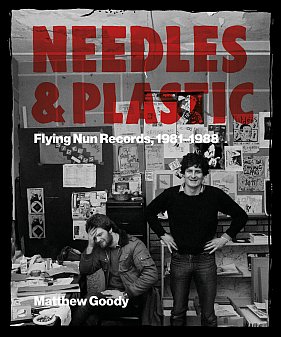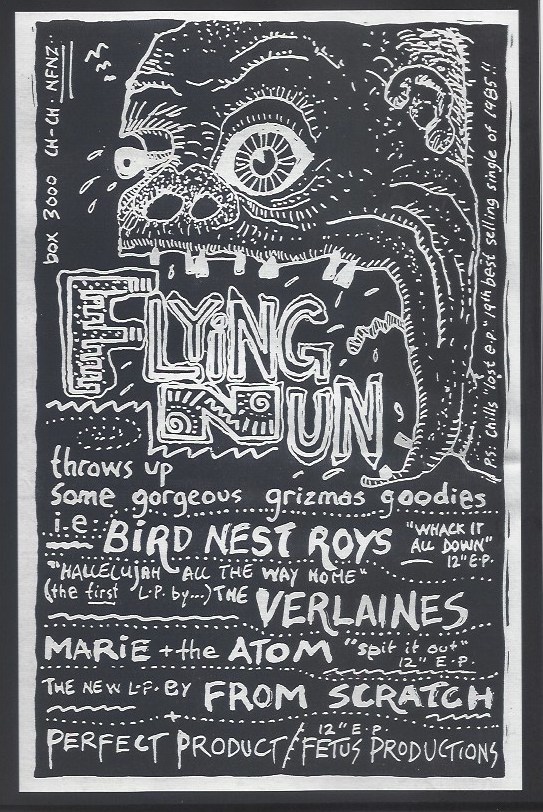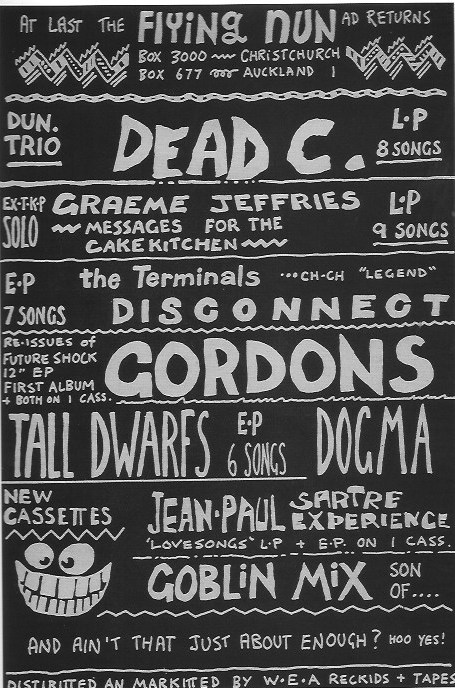Graham Reid | | 4 min read
Anything Could Happen, by the Clean (1981)

In the first few pages of this excellent, readable and informative book, the author Matthew Goody -- an assiduous researcher and clear writer -- outlines some of the problems when attempting this detailed survey of the early years of Flying Nun.
Rather than an overview with anecdotes, Goody has drilled down into a chronological account of every release on the label in that period . . . but there's the first problem with a Nun discography.
Right from the start Nun's idiosyncratic catalogue numbers meant very little.
They were not always sequential: logic would say FN001, FN002 etc but there were multiple FN009s and FN014s. And no FN004 or FN 005.
And the Chills' first releases weren't FN anything, they had their own catalogue identifier COLD.
Then there was the issue of the release timetable: records didn't appear in any timely or even particular manner, some arrived months later (pressing plant issues, cover art problems) and in some instances turned up a year after they had been finished. Bands planned tours and went on the road to support something which wasn't in stores.
Bands could changed members or break up in that time.
The label also put catalogue numbers on releases which weren't strictly Flying Nun's but were just distribution deals for self-released records.
As overseas fan Tom Lax of Siltbreeze Records said, “every label has some system, it may be cryptic but nothing like Flying Nun's. It was like looking at something in a Mayan temple”.
Which in part explains why this book – much talked about for years – took so long in coming.
However it has been worth the wait because it is not, as some rumours had it, simply a numerical or chronological listing of Nun's releases in these formative years with a few details of the musicians.
 Rather it is a swirling but chronological sweep where each release allows Goody to write the background to the band (and the numerous shifting membership between bands) as well as comment on the recording, its cover art where relevant (and with musicians often doing their own art it is a mostly relevant) and include critical comment from the time, drawn from the pages of Rip It Up, fanzines and newspapers.
Rather it is a swirling but chronological sweep where each release allows Goody to write the background to the band (and the numerous shifting membership between bands) as well as comment on the recording, its cover art where relevant (and with musicians often doing their own art it is a mostly relevant) and include critical comment from the time, drawn from the pages of Rip It Up, fanzines and newspapers.
Goody illustrates these 400-plus pages with the covers, band photos, posters, Nun's idiosyncratic newsletters, cartoons and more.
The book looks wonderful, but it is the story which Goody tells with such attention to detail – anecdotes woven around facts, myths debunked, marginal figures restored to the narrative – that makes this an invaluable resource as much as compelling story.
And here's the rub: Goody is not some longstanding Nun follower from Christchurch or Dunedin but a Canadian editor, publisher, researcher and record collector who came to Flying Nun while living in London in 2002 when he first encountered the Clean's Boodle Boodle Boodle EP in that distinctive cover by Chris Knox.
He was only vaguely aware of Flying Nun but grabbed the record and another by This Kind of Punishment. And so his obsession with the label, its music and its artists began.
Perhaps it needed that outsider's eye and ear to tell the Nun story this way. Other avenues (autobiographies, lightweight overviews of “the Dunedin sound”) have all been done.
Now this insightful, measured fan could impose some order on this formative period which ends at a natural point; founder Roger Shepherd leaving Christchurch and relocating to Auckland, Nun entering a distribution deal with a major label WEA.
That first exciting flush of releases and bands was now morphing into something else. Becoming more businesslike in some ways.
Goody not only tells a great story (in bite-sized chunks about each record) but lets personalities shine through: notably Shepherd, his fellow travelers Chris Knox and Doug Hood; the various members of the Clean, Chills, Verlaines and others; promoters and producers and pub owners . . .
 The sheer inclusiveness of Goody's approach means some long forgotten or neglected artists or records are now restored and placed in context: Ritchie Venus and the Blue Beetles, 25 Cent, Balloon D'Esai, Mainly Spaniards, This Sporting Life, the Jessels . . .
The sheer inclusiveness of Goody's approach means some long forgotten or neglected artists or records are now restored and placed in context: Ritchie Venus and the Blue Beetles, 25 Cent, Balloon D'Esai, Mainly Spaniards, This Sporting Life, the Jessels . . .
All these artists and more had their part to play alongside the main players, Tall Dwarfs, Bored Games, Fetus Productions, Sneaky Feelings, Straitjacket Fits . . .
Here too are those acts on Flying Nun who didn't conform to the cliches of lo-fi, heavy reverb, Dunedin guitar sound: Netherworld Dancing Toys at the soul-pop end of the spectrum, Children's Hour and the Skeptics at the bludgeoning other.
Goody incorporates stories of key Looney Tours, the debacle of The Fall album, Nun getting into Europe and the US, the emerging scene in Auckland which provided the label with even more acts . . .
It is a remarkable story given careful attention by someone who not only loves what the label was and stood for, but isn't blind to its faults.
One myth debunked was that Nun got by on a cabal of cheerleading critics and writers who praised every release. Not so as published reviews prove, Nun took the blows from even those most sympathetic to it.
And there was a lot to criticise sometimes: tracks missing from albums, a bass part dropped, muddy sound, poor pressings . . .
Yet through it all Flying Nun and its artists came to define a particular period (largely apolitical however during a volatile time) and in Canadian Matthew Goody they have their historian who gets the facts down but also weaves the personalities, music, scenes and places around them.
An exceptional and well-presented book, essential on any shelf about New Zealand music.
.
Needles and Plastic by Matthew Goody, Auckland University Press, $70





post a comment